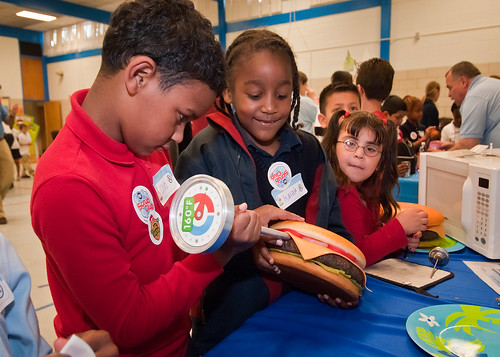
July is the height of summer grilling season and throughout the month USDA is highlighting changes made to the U.S. food safety system over the course of this Administration. For an interactive look at USDA’s work to ensure your food is safe, visit the USDA Results project on Medium.com and read Chapter Seven: Safer Food and Greater Consumer Confidence.
By the time this blog posts today, most readers will have already enjoyed at least one meal. Over their breakfast—fresh fruit, a bacon and egg sandwich, or maybe a grab-n-go energy bar—Americans were probably thinking about all the tasks that meal would fuel them to do for the day, and not whether their food could make them ill. But a strong and diligent network of public servants at the federal, state and local levels were thinking about how to protect you from foodborne illness over their breakfasts this morning, and they’re still thinking about it now. Their job day in and day out is to make sure the food on America’s tables—including yours and theirs—is safe to eat. They are the best in the world at what they do, and they’re constantly getting better.
I have proudly been a part of this team since 1978, when I accepted a job with USDA’s Food Safety and Inspection Service (FSIS) as an inspector in a Dalhart, Texas beef facility. FSIS is the federal agency charged with ensuring the safety of America’s meat, poultry and processed egg supply, and we work hand in hand with the Centers for Disease Control and Prevention (CDC) and the Food and Drug Administration (FDA), as well as state and local departments of health and agriculture. Over the years, I worked my way up from that entry level position in Dalhart, to managing FSIS' Dallas District, to eventually managing the entire agency as Administrator. In my nearly 40-year career, I have seen major changes in the U.S. food safety system.
When I first began as a food inspector, because of the tools available to us and our understanding of what caused foodborne illness at the time, FSIS relied almost exclusively on visual inspection of animals, products, and plant operations. With experience and better technology, our focus as an agency has shifted. Today, we're able to prevent invisible hazards, such as bacterial and chemical contamination.
Under the Obama Administration, the U.S. food safety system has seen some of the most significant updates since the 1950s, adopting a risk-based, data-driven approach to prevent foodborne problems, rather than reacting after something goes wrong. At FSIS, we have accomplished this in the form of tighter and more strategic food safety requirements for food companies, enhanced consumer engagement, and smart innovations to our internal processes. In the past seven years, we’ve adopted a zero-tolerance policy for six dangerous strains of E. coli. We’ve instituted several improvements to poultry inspections that together are expected to reduce Salmonella and Campylobacter illnesses by 67,000 per year. We’ve prevented tons of mislabeled food from entering commerce, and worked with companies to tighten their labeling protocols. And above all, we’ve moved the needle on foodborne illness, watching cases attributed to USDA-regulated product drop by 12 percent.
All of this is possible because every day, 7,500 food safety inspection personnel go to work in more than 6,000 regulated food facilities and 122 ports of entry, where last year they inspected 145 million hogs and cattle, and 9 billion chickens and turkeys, verifying that FSIS regulatory requirements are met. Another 2,000 food safety professionals go to work in three public health laboratories, 10 district offices, and our headquarters office. These employees run test results, dispatch outbreak investigators, and unpack data to reveal telling trends and inform proactive, prevention-based policies that will lead to safer food and fewer illnesses.
Today, USDA is highlighting their work, and that of partners outside of FSIS, in the newest chapter of our 2016 Results project at http://bit.ly/results-ch7. Because their jobs are done largely behind the scenes – at laboratories, alongside private employees in food processing facilities, and sometimes undercover—you may be surprised at the scrutiny given your favorite food products. I encourage you to visit our new chapter to see what we’re doing, and know that we will only continue to improve.
